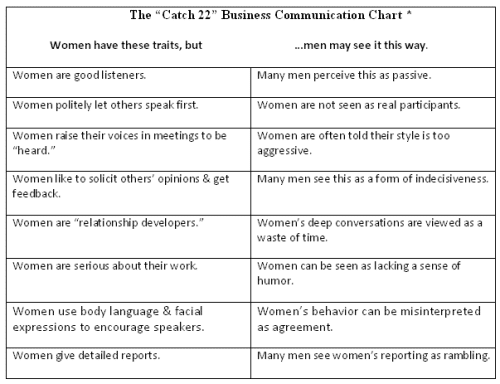Post by Jane K. Stimmler, contributing Women On Business writer
Of all the differences between genders in the workplace, perhaps the most obvious is the stark contrast in the ways women and men communicate. And, in surveys that poll men and women about workplace style, while they may express differing opinions about many things – men and women seem to agree almost unanimously that they have vastly different communication styles. And though these differences permeate interaction in all facets of our lives, it is important for women to make the distinction between “personal” and “business” communication. What works in one does not necessarily translate to the other – and, in the workplace, the consequences can be great for ignoring the issue.
As an example, think about the way women and men report information. Women frequently go into more detail about people, setting, context, drama and inner meaning. Men often skim the surface, touching on a topic and then moving on. Particularly in work environments where there are a number of men, it is important for women to understand how their styles of communication are perceived by others. Without gauging their style and making necessary adjustments, opportunities can be lost for women without their even understanding the reasons.
This is because women’s communication styles are often misconstrued and perceived differently from men’s. This greatly impacts on their ability to be heard, be included, get their ideas across and get ahead in the business world. A woman who responds to being interrupted constantly by her male colleagues by interrupting them can be seen as pushy, but a woman who politely waits in a meeting to be called on and never speaks up is seen as weak. Women must discard some of the polite social behavior they have learned that doesn’t work in the corporate world, such as: wait to be asked your opinion, don’t brag about your accomplishments, be recognized before speaking, and don’t dominate the conversation.
Have you ever been complimented for being a good listener? Or told that you have the knack of including everyone’s opinions and thoughts in a group setting? While you may think of these traits as positives – and in many situations they are — they don’t necessary translate that way to the business world. The chart below lists a number of characteristics of women’s communication which are in this “Catch 22” category.

*from Breaking Into the Boys’ Club copyright 2009
Think about these issues and their potential to create mistaken impressions and see if you are tempted to make any changes to your communication style. I’ll be covering these different aspects of communication in my upcoming blogs, and I would love to hear your stories and comments.
What communication issues have you encountered in the workplace?





This post highlights something that women must be careful off – don’t take your advice solely from a man who is telling you how to react as a man. While men do not necessarily view many of the communication traits of women as positive, the most certainly don’t think it a good thing to have a woman acting just like a man.
The trick, as Jane points out, is to be aware of the differences in perception and make adjustments to your style until you have one that is effective, uniquely you, and still uniquely that of a woman.
Cecilia Edwards
Equipping Businesses for Phenomenal Success
http://www.ceciliaedwards.com